How to care for remontant raspberries in the fall
Purchasing and planting modern, highly productive varieties of remontant raspberries does not mean that the crop will produce abundant harvests every year. Caring for it has its own characteristics, which differ from caring for ordinary raspberries. Although the variety is considered frost-resistant, experienced gardeners must prepare the plant for winter by performing fairly simple procedures.
What to do in the fall with remontant raspberries
Those who are considered repairable are those raspberry varieties, which bear fruit on shoots of the first and second year. They are cultivated both as an annual crop (only one autumn harvest is harvested) and as a biennial crop (the first harvest in the summer is from branches of the second year of life and the second harvest in the fall is from new annual shoots).
Remontant raspberries differ significantly from ordinary ones in both care and preparation time for winter. For example, when pruning is carried out in a regular raspberry field, the harvest is being harvested in full swing in a remontant one.
Caring for raspberries in the fall and preparing for winter are important activities that allow you to preserve the bushes and provide yourself with a good harvest. Timely and high-quality work will have a beneficial effect on the number and size of berries and the plant’s resistance to certain diseases.
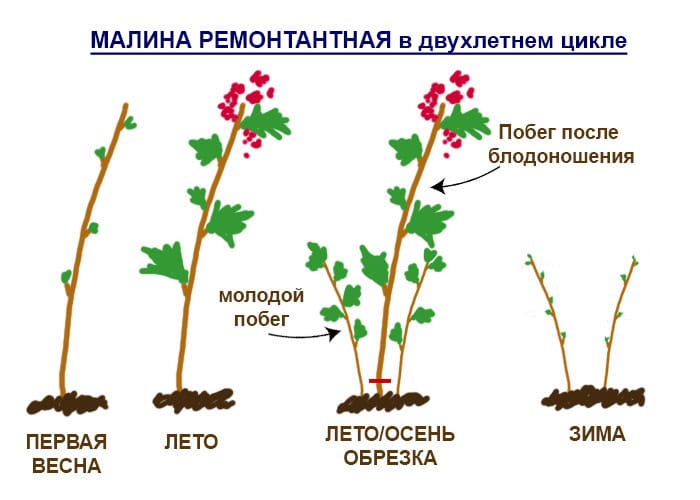
Autumn care and winter preparation activities include:
How to properly plant remontant raspberries in the fall
It is important to choose the correct planting dates depending on the region and prepare the seedlings.
Landing dates
Raspberries are planted in the fall only in dry and warm weather. More exact dates depend on the area:
- In the northwestern part of Russia, the Leningrad region, Siberia and the Urals, remontant raspberries are planted in early autumn, since the first frosts in these areas come early.
- In the middle zone - during September.
- On South - in October.
Preparation of seedlings and growth sites
It is advisable to plant raspberries away from wetlands, as they will not take root in them. The area should be illuminated so that the sun warms the plants well.
Reference. With a lack of sunlight, the shoots begin to stretch, and leaves fall from their lower parts. This leads to a decrease in the quality and quantity of berries.
It is advisable to place bushes away from places with strong winds. Usually they try to plant raspberries along some kind of fence.
A year before planting the planting material, green manure is sown in the intended location. They help cleanse the soil of harmful substances and improve its structure. During autumn digging, green manure will become a good fertilizer. To do this, plant lupine, mustard or oats.
The choice of planting material is also an important stage. Some gardeners prefer to use root cuttings, but seedlings are still more reliable. They must be healthy and strong, have a developed root system. The diameter of the stem near the roots is 5-8 mm. The above-ground part should consist of several branches.
It is also important to pay attention to the thin and curved roots that are located at the base of the roots. It is desirable that their length be about 20 cm. The more of these roots, the better.
Planting process
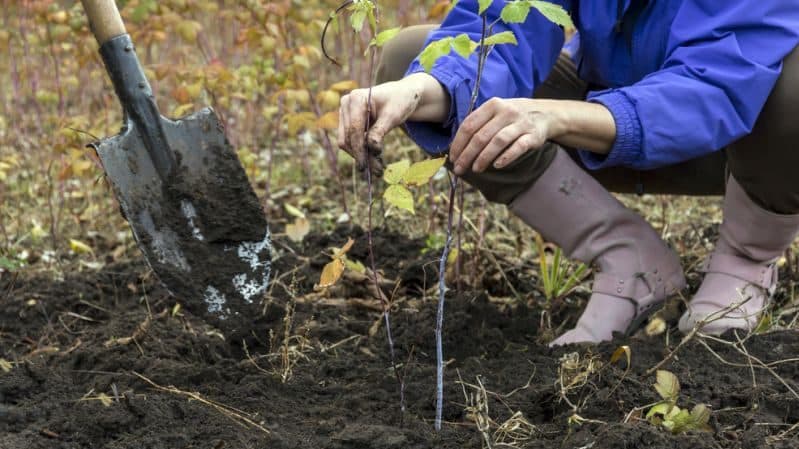
The technology for planting young seedlings is quite simple. After choosing a location, dig a hole about 30 cm deep.Humus or rotted manure is poured into the bottom - about 1/2 of a bucket.
The seedling is watered and removed from the pot. After this, it is placed in the hole, covered with earth and compacted a little. Now water and mulch. The mulch layer is about 10 cm.
Constant watering in autumn is usually not required for young seedlings. But if the soil is dry, then water the plants once a week. During this, it is advisable to dissolve potassium fertilizers in water, which improve survival rate.
Caring for remontant raspberries in autumn
Autumn care is very important for obtaining a good harvest. Remontant raspberries require pruning, feeding, treatment from various pests.
Watering and fertilizing

To support raspberry bushes after harvesting, they are watered. This is most relevant for the southern regions, where autumn weather is often dry and warm, and little snow falls in winter. In this area, water quickly evaporates or freezes, so watering is important.
In the middle zone, autumn is usually rainy. Because of this, the last watering is carried out at the end of September. It is important to shed the soil to a depth of at least 40 cm.
Autumn watering is controlled depending on weather conditions. Due to wet soil and warm weather, there is a chance of new shoots forming. This will lead to the depletion of the earth. New branches will not have time to get stronger before winter, so they will die. Watering is accompanied by pruning of bushes.
In autumn, raspberries require fertilizing to support them after the growing season and fruiting. To do this, add humus to the soil at the rate of 1 bucket per bush and mineral fertilizers. Potassium salt and superphosphates are added 1 tsp each. per plant. If the soil is sandy, the amount of fertilizer is doubled.
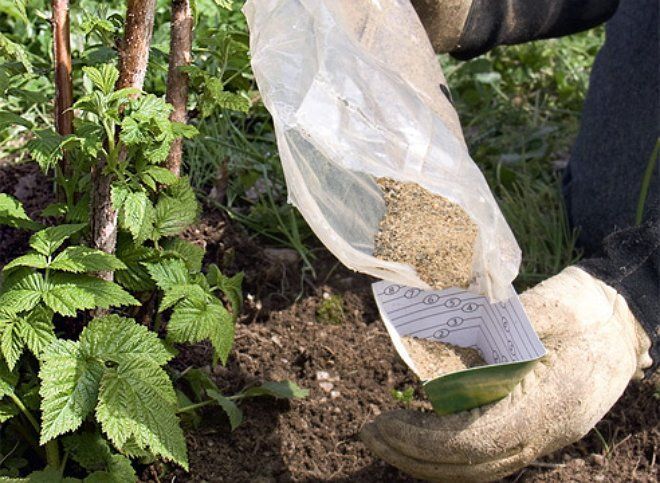
Pest treatment
Insecticides are used against weevils, raspberry beetles, spider mites and other insects. The most popular of them:
- "Aktellik";
- "Intavir";
- "Fufanon."
Solutions are made according to the instructions on the package.
Folk remedies are also suitable in the fight against raspberry beetles. For example, an infusion of wormwood and marigold is often used. Take 100 g of these plants and pour 1 liter of water, leave in different containers for 2 days. After this, the infusions are combined and mixed thoroughly. This product is used to treat the plant and the soil around it.
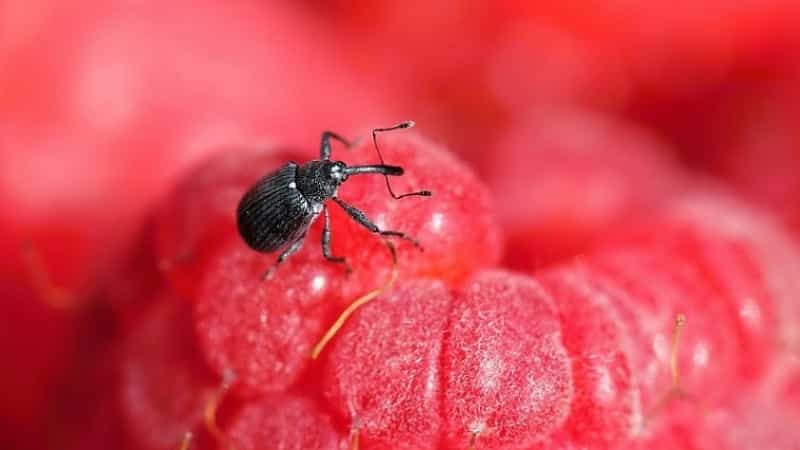
Kidney moths are combated using the following drugs:
- "Spark";
- "Decis";
- "Confidor".
Before using these products, be sure to remove all dry leaves.
For caterpillars and glass cases, use “Karbofos” and “Nitrafen”. Also against these pests use mustard solution. 100 g of powder is dissolved in 5 liters of water. Then the resulting product is sprayed on the plants.
Raspberry gall midge is one of the most dangerous pests. It resembles a mosquito and lays eggs on branches. Caterpillars emerge from them and eat young shoots. To get rid of this pest, mix 1.5 tbsp. l. "Karbofos" and 1 tbsp. l. chlorophos, diluted in 10 liters of water. The resulting product is sprayed onto the bushes.
There is also a folk method for destroying gall midges. 0.5 kg of chopped garlic is infused in 8 liters of water for 24 hours. After this, 20 laundry soap is added there. Mix everything thoroughly. Spray twice with an interval of 4 days.
Trimming
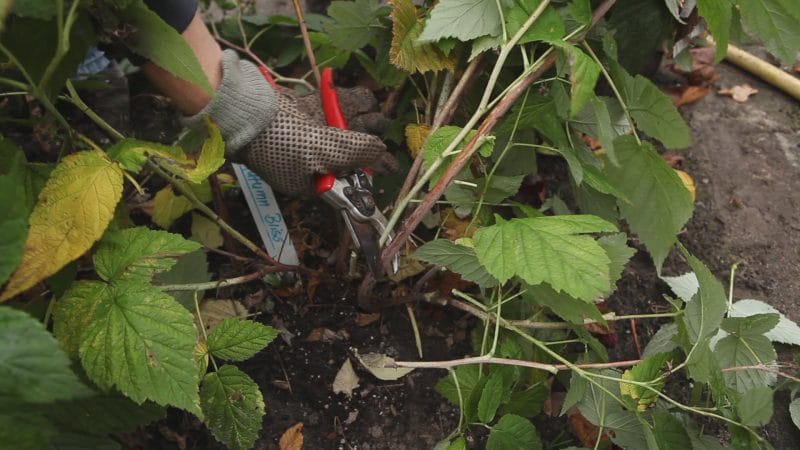
Autumn care for remontant raspberries necessarily includes pruning. This procedure helps:
- Prevention of excessive thickening of bushes, which significantly reduces fruiting rates.
- Formation of a beautiful plant.
- Increased resistance to diseases and pests.
- Penetration of sunlight and fresh air.
If raspberries are planted this season, then only gentle pruning is carried out. In this case, only the tips of the shoots are cut off, leaving approximately 20 cm in length.
A maximum of 8 branches are left on each bush. Before carrying out the procedure, it is important to choose the right moment. The first frost should already be here. When pruning is done in warm and sunny weather, new shoots and buds will begin to form. If it suddenly gets colder after this, the branches will freeze, which will lead to the death of the entire bush.
Some gardeners grow remontant raspberries as an annual. To stimulate fruiting next season, all branches are removed. No more than 3 cm of their length is left above the ground. Pruning is carried out with a sharp and disinfected instrument.
Two-year-old shoots that have already produced crops several times are cut off completely. The stumps are made slightly below ground level, otherwise pathogenic microflora will begin to multiply on them.
Important. In the case of the Yellow Giant variety, two-year-old shoots are not pruned, since they are the ones that show the greatest fruiting. For such raspberries, only the ends are shortened.
Damaged and weak branches must be cut off. If they show signs of disease or the presence of insects, they are immediately burned.
Damaged shoots are removed not only in autumn, but also in spring. This will significantly increase the quantity and improve the quality of the fruit.
Transplanting remontant raspberries
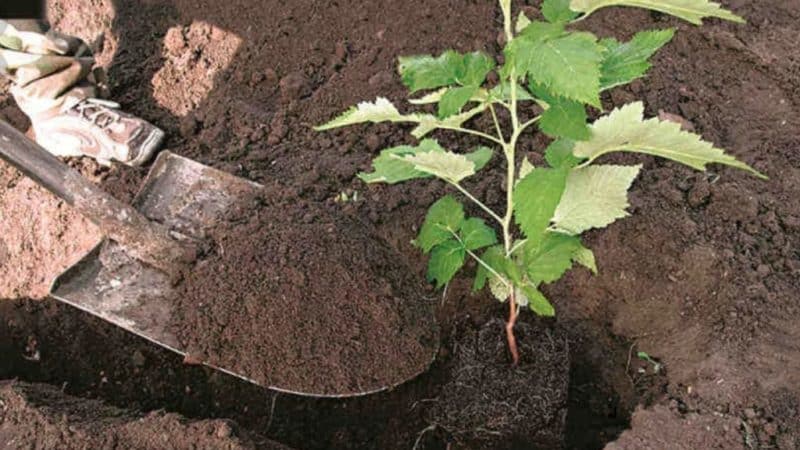
Deadlines for the autumn transplants based on the raspberry growing region:
- IN Moscow regionIn the Volga region and the middle zone, the procedure is performed throughout September, provided that weather conditions are favorable.
- In the northern regions, they are replanted in early September if the weather is dry and warm. It is impossible to plant bushes in rain and cold.
- In the southern regions, transplantation is carried out until the end of November, but only in dry weather.
The new place for remontant raspberries should be protected from cold winds and have as much light as possible. It is also impossible for water to linger on it during the spring thaw, as this will lead to rotting of the root system.
The best predecessors:
- cucumbers;
- garlic and onion;
- zucchini or zucchini;
- legumes;
- lupine, buckwheat, oats and other green manures.
Raspberries are transplanted into loamy or sandy loam soil, which has low acidity. If it is not possible to do this, then the earth is deoxidized using ash, slaked lime or chalk. For 1 sq. m area, 2-3 kg of the substance are scattered. After this, the earth is dug up, breaking up the lumps.
Soil preparation and selection of bushes:
- 1 month before transplanting, the soil is dug up and loosened.
- Combine 25 kg of compost with 60 g of potassium sulfate and 70 g of superphosphate. This mixture is applied per 1 sq. m.
- For replanting, choose medium-sized bushes and only healthy ones.
- They dig them in with a pitchfork and take them out along with a lump of earth.
- Using a sharp knife, divide the bush into several parts, removing damaged shoots.
- The roots are dipped in a mixture of clay and water.
- The branches are cut to 50 cm and all foliage is removed from them.
Main stages of planting:
- They dig holes for each bush with a depth, width and length of 50 cm. A gap of 1 m is left between the rows, and 0.8 m between the holes.
- A drainage layer of about 20 cm is poured onto the bottom. After this, sprinkle with earth.
- Add 200 g of wood ash on top and install a seedling.
- Straighten the roots and cover them with soil, compacting them a little.
- Each plant is watered with a bucket of warm water and mulched with straw, sawdust or spruce branches.
- After 15 days, water the bushes with any growth stimulant, for example “Kornevin”. The procedure is repeated after a month.
Before the arrival of frost, each plant is watered with 10 liters of water and covered with any heat-insulating material.
Conclusion
In order for remontant raspberries to produce a good harvest, you will have to work hard in the fall. Pest control, pruning, watering and fertilizing are important steps that are carried out during preparation for winter. But next season the plants will delight you with tasty and healthy berries.
Some kind of understatement about caring for remontant raspberries. Almost like a regular one. But this is not so. After reading this article, the summer resident will fight for the harvest for several years.
It would be great if in your comment you could help summer residents with experienced advice.